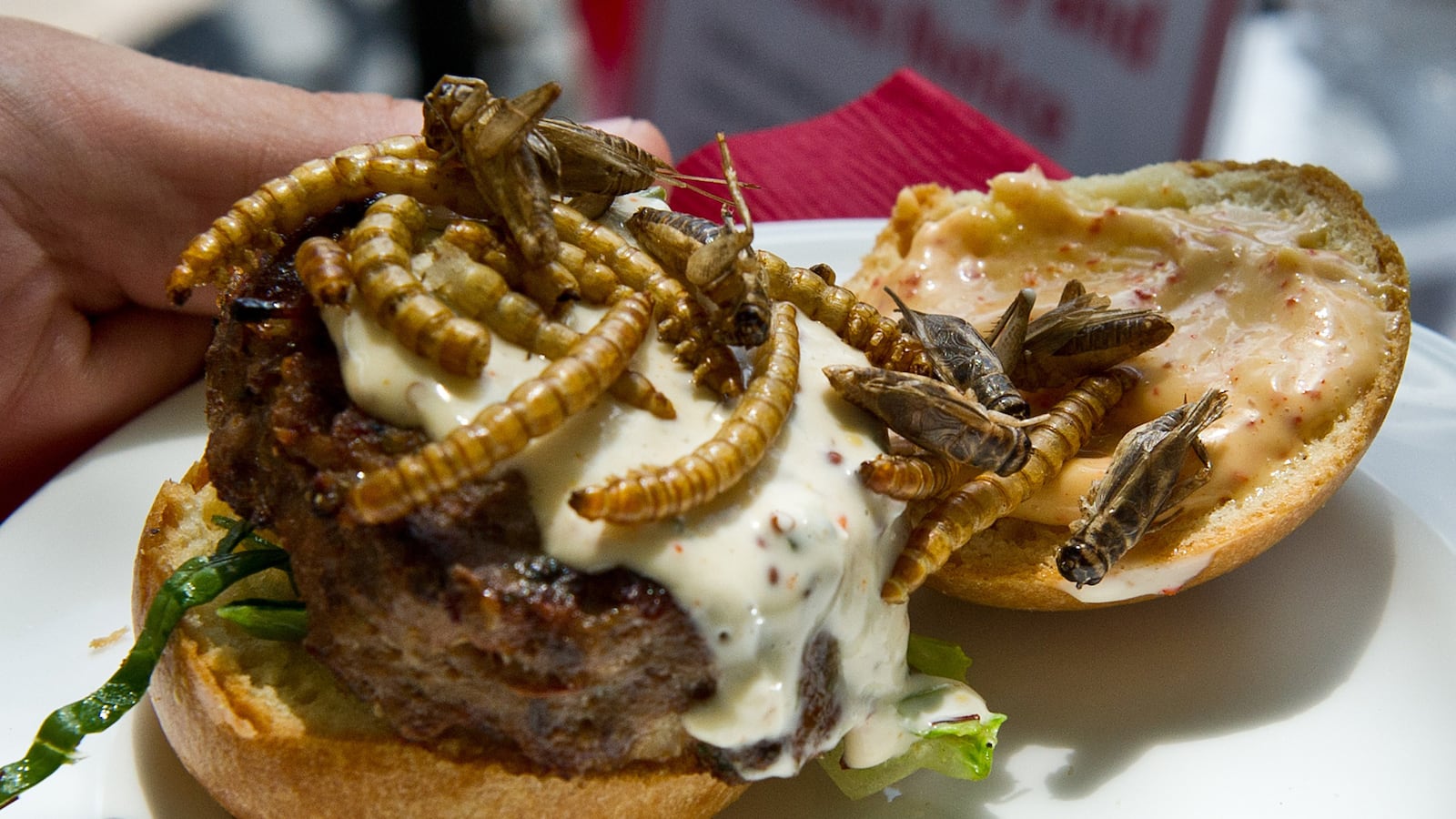Two all-beef patties, special sauce, lettuce, cheese, pickles, onions—on a sesame seed bun. The Big Mac’s anthem, made famous by its signature ’70s jingle, is firmly engrained in the collective consciousness of meat-eating America. But these days the traditional hamburger as we’ve known it has been co-opted by an unusual assortment of add-ons like caviar and foie gras. Are our beloved burgers forever evolving beyond the classics toward an endless stack of superlatives?
“It’s the perfect blank canvas,” states Amanda Downing who, as the chef of Chicago’s famous Rockit Burger Bar, has been at the helm of a menu’s worth of seriously inventive dishes, including a “Mac & Cheese Attack” (essentially a quarter-pound black angus patty between two fried mac and cheese buns plus other fixings like sriracha ketchup), and a “BDF Burger” (think breakfast for dinner: fried egg, bacon, cheese and an all-beef patty between a glazed doughnut bun). “You expect comfort food out of the Midwest, and a burger is a vehicle for people to try something more adventurous in a familiar and safe space.”
Ray Dawson, director of culinary operations at the International Culinary Center, echoes Downing’s approach to thinking outside the bun. “We jazz up burgers because we can. You can add anything to it because it has a neutral flavor profile in itself.” Charged with initiating scores of new students, Dawson champions decorating the blank burger in his kitchen both as a way of instilling proper cooking techniques in his chefs-to-be, and also as a conduit to sample the spectrum of new technologies available, from boutique pickling to molecular gastronomy.
But why does the burger get the distinct honor of being everyone’s favorite test subject, and not one of the other fixtures of the American dinner table?
According to Bronwen Hanna-Korpi, the president of the Belcampo Meat Company’s restaurants and butcher shops in California, it’s simple math. “Contrary to what you might think, burgers have never been a consumer-driven product. It’s always been pushed by the vendors—beef ground is cheap.”
While ribeyes and tenderloins are the sought-after cuts of middle meat, they make up such a small proportion of the cow that it’s crucial to sell other bits of the bovine in order to turn a profit. “It’s simple and kind of strategic: Burgers are an efficient way to use the cow’s trim. As a butcher it’s imperative to move as much of the animal as possible.”
For years the need to push patties took the form of thin-cut ground beef served in fast-food joints and backyard barbecues. Then, in the early naughts, something changed. “Suddenly there was a trend to elevate comfort food,” continues Hanna-Korpi. “I think it came out of the hipster kitchens in Brooklyn and Oakland. Everyone wanted healthier versions of familiar dishes—that’s what ushered in the food movement we’re in now.”
But it hasn’t undermined the McDonald’s behemoth. Although the fast-food conglomerate has faced an uphill battle against ‘fast casual’ establishments promising healthier fare, it remains the most visited business in the U.S. with roughly 17 Big Macs sold every second. The heart wants what it wants, even if it clogs an artery.
However, a rise in burger quality forcibly scooped up McDonald’s and its competing fast-food chains who, while never changing the recipes of their signature dishes, had to suddenly allow for more transparency in the preparation of their sandwiches, and thus commit to a higher standard of production.
As chefs set their sights upon upgrading the hamburger, an agreed-upon definition of the classic version was needed. Generally there are two persuasions: the paper-thin patty cooked in seconds and bedecked with an assortment of basic condiments (ketchup, mustard, lettuce, tomato), and the inch-thick ground steak that allows for variations in temperature and interior coloring.
The proliferation of zany burger toppings came next as an inevitable by-product of the high-end burger fad. This was especially prominent among the camp of chefs who preferred to experiment with an elevated version of the traditional fast-food patty, its thin proportions never yielding an explosion of flavor, allowing bolder toppings to shine through. And thus began a game of “have it your way” one-upsmanship between restaurants, as the patty swapped its neighboring pickle for something from the lexicon of haute cuisine.
Fueled by a heady mix of bragging rights, shock value, food porn, and the nation’s fascination with extreme eating, the burger continues to plow its way across the dinner table, challenging traditional norms as the hallmark of American innovation in kitchen. And many chefs on the ground believe there’s still a long way to go.
“Have we found burger Utopia? Not even close,” posits Thomas G. Dritsas, the vice president and executive chef of the nationwide Del Frisco’s group. He sees topping tweaking as an essential part of the conversation while “chefs and burger fans continue to break the mold and put the definition of the burger to the test…from ethnic influences to health and eating trends.”
Other players in the industry believe that the days of the foie gras fixin’ are numbered. “I love foie gras. Then I ordered it on a hamburger once, and found it made no sense at all,” ventures Pat LaFrieda, the name behind the multi-generational meat purveyor to major outlets in the New York tri-state area like Shake Shack and the Spotted Pig.
LaFrieda, whose definitive guide to all things meat drops at the end of summer, has been carefully documenting the tendency to beef up the burger, so to speak, and sees a variety of crucial elements that trump the items we stuff between the patty and the bun.
“Ten years ago it was all about ‘organic’ and ‘grass-fed,’ then we re-evaluated when the meat had a slightly bitter flavor and not enough intramuscular fat.” It seems that the success to LaFrieda’s enterprise lies in calibrating the knob back and forth in search of the perfect produce, and this may be the secret to achieving peak burger as well. “Toppings are trendy; the next big thing is going to be the quality and the blends of the meat patties themselves.”
LaFrieda predicts that a focused look at the provenance of the beef will start a new dialog about blends and a true consumer understanding of the different cattle feeds and how they affect the meat’s flavor. “As my grandfather—the original Pat LaFrieda—used to say: You can’t hide your sins in the grinder.”
It may sounds like a scene ripped straight from a Portlandia episode, but LaFrieda has already seen a rise in genuine interest about the precise origins of his produce. “Traceability is important now. People want to know that this beef is from a ranch in Kansas.”
Focusing more on the quality of the meat falls firmly in line with a change in the prevailing winds. Toppings may be the veritable paints on the chefs’ palettes in the restaurants, but they don’t hold the secret to creating the perfect burger. Instead, LaFrieda, Hanna-Korpi, and Dawson all see a general back-to-basics approach from hereon in.
“I’ve judged a ton of burger contests,” adds LaFrieda, “and after chomping through dozens of entries, the burgers that always take home the prize are the ones with the simplest ingredients: a great patty, a dab of special sauce, American cheese, and a white enriched bun.”






